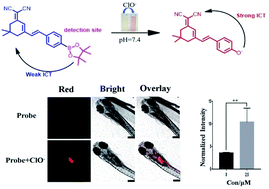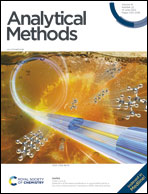A NIR fluorescent probe for the specific detection of hypochlorite and its application in vitro and in vivo†
Abstract
It is of great necessity to exploit a real-time, highly selective and sensitive method for hypochlorite (ClO−) detection in both the environment and living systems because of the complex influence of ClO− on health. In this paper, based on the intramolecular charge transfer (ICT) effect, a NIR fluorescent probe (probe DAB) was designed for the accurate detection of ClO−, which produced a fluorescence response to ClO− with high selectivity and rapid response (within 1 min). The probe DAB could determine ClO− over the linear range of 0–80 μM with a low detection limit of 1.46 μM. And the sensing mechanism between the probe and ClO− was verified using HPLC and MS. To further prove its practicability, the probe was applied for detecting ClO− in actual water samples. In addition, owing to its good sensing properties and low cytotoxicity, probe DAB could be expediently applied to visualize ClO− in living cells and zebrafish, and it is expected to be a useful tool for investigating the detailed functions and mechanisms of ClO− in living systems.



 Please wait while we load your content...
Please wait while we load your content...